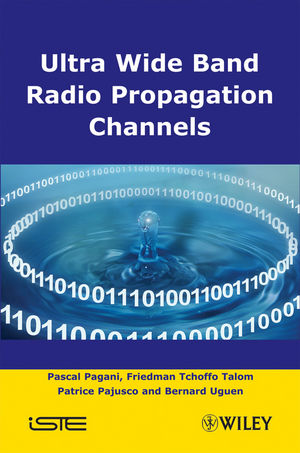Ultra-Wideband Radio Propagation Channels: A Practical ApproachISBN: 978-1-84821-084-4
Hardcover
352 pages
January 2009, Wiley-ISTE
 |
||||||
Foreword 11
Acronyms 17
Chapter 1. UWB Technology and its Applications 21
1.1. Introduction 21
1.2. Definition and historical evolution 22
1.2.1. Definition 22
1.2.2. Historical evolution 23
1.3. Specificities of UWB 24
1.4. Considered applications 26
1.5. Regulation evolution 30
1.5.1. Regulation in the USA 31
1.5.2. Regulation in Europe 32
1.5.3. Regulation in Asia 33
1.6. UWB communication system and standardization 34
1.6.1. Impulse radio 35
1.6.1.1. Pulse position modulation 35
1.6.1.2. Pulse amplitude modulation 38
1.6.2. Direct sequence UWB 39
1.6.3.Multiband OFDM 40
1.7. Conclusion 41
Chapter 2. Radio Wave Propagation 43
2.1. Introduction 43
2.2. Definition of the propagation channel 43
2.2.1. Free space propagation 44
2.2.2. Multipath propagation 45
2.2.3. Propagation channel variations 47
2.2.3.1. Spatial selectivity 48
2.2.3.2. Frequency selectivity 48
2.2.3.3. Doppler effect 50
2.3. Propagation channel representation 51
2.3.1.Mathematical formulation 51
2.3.2. Characterization of deterministic channels 52
2.3.2.1. The time varying impulse response 53
2.3.2.2. The frequency domain function 53
2.3.2.3. The time varying transfer function 54
2.3.2.4. The delay-Doppler spread function 54
2.3.3. Characterization of linear random channels 54
2.3.4. Channel classification 55
2.3.4.1.Wide sense stationary channels 55
2.3.4.2. Uncorrelated scattering channels 56
2.3.4.3. Wide sense stationary uncorrelated scattering channels 57
2.4. Channel characteristic parameters 58
2.4.1. Frequency selectivity 58
2.4.1.1. RMS delay spread 59
2.4.1.2. Coherence bandwidth 59
2.4.1.3. Delay window and delay interval 60
2.4.1.4. Exponential decay constants 61
2.4.1.5. Cluster and ray arrival rates 61
2.4.2. Propagation loss 62
2.4.3. Fast fading 63
2.4.4. Spectral analysis 64
2.5. Conclusion 64
Chapter 3. UWB Propagation Channel Sounding 67
3.1. Introduction 67
3.2. Specificity of UWB channel sounding 67
3.3. Measurement techniques for UWB channel sounding 70
3.3.1. Frequency domain techniques 71
3.3.1.1. Vector network analyzer 71
3.3.1.2. Chirp sounder 72
3.3.2. Time domain techniques 73
3.3.2.1. Pulsed techniques 73
3.3.2.2. Correlation measurements 75
3.3.2.3. Inversion techniques 78
3.3.3. Multiple-band time domain sounder for dynamic channels 78
3.3.3.1. Principle of multiple-band time domain sounding 80
3.3.3.2. Description of the SIMO channel sounder 81
3.3.3.3. Extension towards UWB 81
3.3.3.4. Experimental validation 84
3.4. UWB measurement campaigns 85
3.4.1. Overview of UWB measurement campaigns 85
3.4.2. Illustration of channel sounding experiments 91
3.4.2.1. Static measurement campaign over the 3.1–10.6 GHz band 91
3.4.2.2. Static measurement campaign over the 2–6 GHz band 95
3.4.2.3. Dynamic measurement campaign over the 4–5 GHz band 95
3.5. Conclusion 98
Chapter 4. Deterministic Modeling of the UWB Channel 99
4.1. Introduction 99
4.2. Overview of deterministic modeling 99
4.2.1. FDTD based approach 100
4.2.2.MoMbased approach 100
4.2.3. Ray based approach 101
4.3. Specificity of deterministic modeling in UWB 101
4.4. Overview of UWB deterministic modeling 102
4.4.1. Qiu model 102
4.4.2. Yao model 102
4.4.3. Attiya model 103
4.4.4. Uguen and Tchoffo Talom model 104
4.5. Illustration of a deterministic model formalism 104
4.5.1. Received signal synthesis 105
4.5.2. Ray impulse response without delay 105
4.5.3. Ray channel matrix without delay 108
4.5.4. Described model results 110
4.5.4.1. Emitted waveform and considered scenario 110
4.5.4.2. Channel matrix of each emitted waveform in the LOS case 113
4.5.4.3. Received signal with ideal antennas 114
4.6. Consideration of real antenna characteristics in deterministic modeling 118
4.7. Building material effects on channel properties 120
4.8. Simulation and measurement comparisons 124
4.8.1. Evaluation of real antenna consideration 124
4.8.2. Evaluation of impulse response reconstruction 125
4.9. Conclusion 126
Chapter 5. Statistical Modeling of the UWB Channel 133
5.1. Experimental characterization of channel parameters 134
5.1.1. Propagation loss 134
5.1.1.1. Frequency propagation loss 134
5.1.1.2. Distance propagation loss 136
5.1.2. Impulse response characterization 137
5.1.2.1. Delay spread 137
5.1.2.2. Power delay profile decay 141
5.1.2.3. Ray and cluster arrival rate 145
5.1.3. Study of small-scale channel variations 148
5.1.4. Effect of moving people 151
5.1.4.1. Observation of temporal variations 151
5.1.4.2. Slow fading 152
5.1.4.3. Fast fading 153
5.1.4.4. Spectral analysis 156
5.2. Statistical channel modeling 157
5.2.1. Examples of statistical models 158
5.2.1.1. IEEE 802.15.3a model 158
5.2.1.2. IEEE 802.15.4a model 159
5.2.1.3. Other models 160
5.2.2. Empirical modeling principles 162
5.2.2.1. Propagation loss model 162
5.2.2.2. Modeling the channel impulse response over an infinite bandwidth 163
5.2.2.3. Modeling the channel impulse response over a limited bandwidth 166
5.2.2.4. Simulation results 166
5.3. Advanced modeling in a dynamic configuration 169
5.3.1. Space variation modeling 169
5.3.2.Modeling the effect of people 172
5.4. Conclusion 175
Appendices
A. Baseband Representation of the Radio Channel 177
B. Statistical Distributions 181
B.1. Definition 181
B.1.1. Rayleigh distribution 181
B.1.2. Rice distribution 182
B.1.3. Nakagami distribution 183
B.1.4.Weibull distribution 184
B.1.5. Normal distribution 184
B.1.6. Log-normal distribution 185
B.1.7. Laplace distribution 185
B.2. Kolmogorov-Smirnov goodness-of-fit test 186
C. Geometric Optics and Uniform Theory of Diffraction 189
C.1. Geometric optics 189
C.1.1. Introduction 189
C.1.2. Field locality principle 190
C.1.3. Field expression in geometric optics 191
C.1.4. Change of local basis 192
C.1.5. Incident field 192
C.1.6. Reflected field 193
C.1.7. Refracted and transmitted field 197
C.2. Uniform theory of diffraction 200
C.2.1. Introduction 200
C.2.2. Diffracted field 200
C.2.3. UTD 2D coefficient 201
C.2.4. UTD 3D coefficient 204
D. Ray Construction Techniques 209
D.1. Ray launching 209
D.2. Ray tracing 209
D.3. Other techniques 211
E. Description of the Time-Frequency Transform 213
Bibliography 219
Index 237



